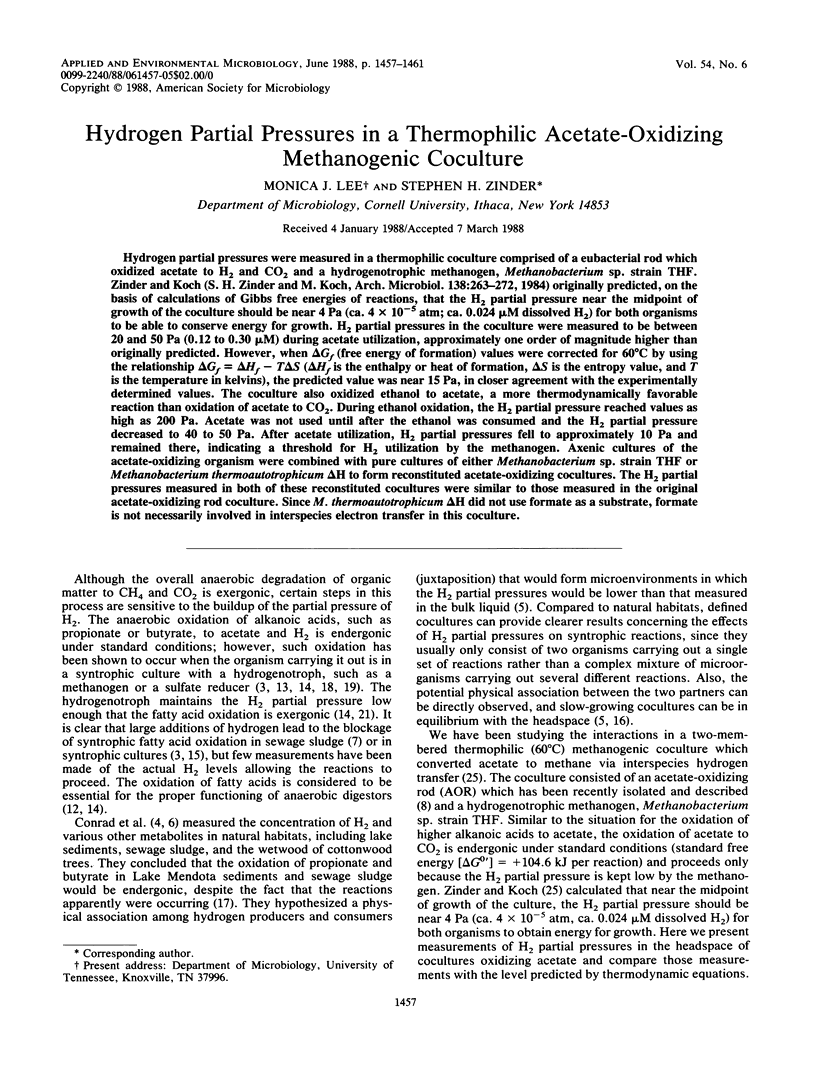Hydrogen Partial Pressures in a Thermophilic Acetate-Oxidizing Methanogenic Coculture (original) (raw)
Abstract
Hydrogen partial pressures were measured in a thermophilic coculture comprised of a eubacterial rod which oxidized acetate to H2 and CO2 and a hydrogenotrophic methanogen, Methanobacterium sp. strain THF. Zinder and Koch (S. H. Zinder and M. Koch, Arch. Microbiol. 138:263-272, 1984) originally predicted, on the basis of calculations of Gibbs free energies of reactions, that the H2 partial pressure near the midpoint of growth of the coculture should be near 4 Pa (ca. 4 × 10−5 atm; ca. 0.024 μM dissolved H2) for both organisms to be able to conserve energy for growth. H2 partial pressures in the coculture were measured to be between 20 and 50 Pa (0.12 to 0.30 μM) during acetate utilization, approximately one order of magnitude higher than originally predicted. However, when Δ_G_ f (free energy of formation) values were corrected for 60°C by using the relationship Δ_G_ f = Δ_H_ f − T_Δ_S (Δ_H_ f is the enthalpy or heat of formation, Δ_S_ is the entropy value, and T is the temperature in kelvins), the predicted value was near 15 Pa, in closer agreement with the experimentally determined values. The coculture also oxidized ethanol to acetate, a more thermodynamically favorable reaction than oxidation of acetate to CO2. During ethanol oxidation, the H2 partial pressure reached values as high as 200 Pa. Acetate was not used until after the ethanol was consumed and the H2 partial pressure decreased to 40 to 50 Pa. After acetate utilization, H2 partial pressures fell to approximately 10 Pa and remained there, indicating a threshold for H2 utilization by the methanogen. Axenic cultures of the acetate-oxidizing organism were combined with pure cultures of either Methanobacterium sp. strain THF or Methanobacterium thermoautotrophicum ΔH to form reconstituted acetate-oxidizing cocultures. The H2 partial pressures measured in both of these reconstituted cocultures were similar to those measured in the original acetate-oxidizing rod coculture. Since M. thermoautotrophicum ΔH did not use formate as a substrate, formate is not necessarily involved in interspecies electron transfer in this coculture.

Selected References
These references are in PubMed. This may not be the complete list of references from this article.
- Ahring B. K., Westermann P. Thermophilic anaerobic degradation of butyrate by a butyrate-utilizing bacterium in coculture and triculture with methanogenic bacteria. Appl Environ Microbiol. 1987 Feb;53(2):429–433. doi: 10.1128/aem.53.2.429-433.1987. [DOI] [PMC free article] [PubMed] [Google Scholar]
- Boone D. R., Bryant M. P. Propionate-Degrading Bacterium, Syntrophobacter wolinii sp. nov. gen. nov., from Methanogenic Ecosystems. Appl Environ Microbiol. 1980 Sep;40(3):626–632. doi: 10.1128/aem.40.3.626-632.1980. [DOI] [PMC free article] [PubMed] [Google Scholar]
- Conrad R., Aragno M., Seiler W. Production and consumption of hydrogen in a eutrophic lake. Appl Environ Microbiol. 1983 Feb;45(2):502–510. doi: 10.1128/aem.45.2.502-510.1983. [DOI] [PMC free article] [PubMed] [Google Scholar]
- Conrad R., Phelps T. J., Zeikus J. G. Gas metabolism evidence in support of the juxtaposition of hydrogen-producing and methanogenic bacteria in sewage sludge and lake sediments. Appl Environ Microbiol. 1985 Sep;50(3):595–601. doi: 10.1128/aem.50.3.595-601.1985. [DOI] [PMC free article] [PubMed] [Google Scholar]
- Lee Monica J., Zinder Stephen H. Isolation and Characterization of a Thermophilic Bacterium Which Oxidizes Acetate in Syntrophic Association with a Methanogen and Which Grows Acetogenically on H(2)-CO(2). Appl Environ Microbiol. 1988 Jan;54(1):124–129. doi: 10.1128/aem.54.1.124-129.1988. [DOI] [PMC free article] [PubMed] [Google Scholar]
- Lovley D. R., Dwyer D. F., Klug M. J. Kinetic analysis of competition between sulfate reducers and methanogens for hydrogen in sediments. Appl Environ Microbiol. 1982 Jun;43(6):1373–1379. doi: 10.1128/aem.43.6.1373-1379.1982. [DOI] [PMC free article] [PubMed] [Google Scholar]
- Lovley D. R., Ferry J. G. Production and Consumption of H(2) during Growth of Methanosarcina spp. on Acetate. Appl Environ Microbiol. 1985 Jan;49(1):247–249. doi: 10.1128/aem.49.1.247-249.1985. [DOI] [PMC free article] [PubMed] [Google Scholar]
- Lovley D. R. Minimum threshold for hydrogen metabolism in methanogenic bacteria. Appl Environ Microbiol. 1985 Jun;49(6):1530–1531. doi: 10.1128/aem.49.6.1530-1531.1985. [DOI] [PMC free article] [PubMed] [Google Scholar]
- Mackie R. I., Bryant M. P. Metabolic Activity of Fatty Acid-Oxidizing Bacteria and the Contribution of Acetate, Propionate, Butyrate, and CO(2) to Methanogenesis in Cattle Waste at 40 and 60 degrees C. Appl Environ Microbiol. 1981 Jun;41(6):1363–1373. doi: 10.1128/aem.41.6.1363-1373.1981. [DOI] [PMC free article] [PubMed] [Google Scholar]
- McInerney M. J., Bryant M. P., Hespell R. B., Costerton J. W. Syntrophomonas wolfei gen. nov. sp. nov., an Anaerobic, Syntrophic, Fatty Acid-Oxidizing Bacterium. Appl Environ Microbiol. 1981 Apr;41(4):1029–1039. doi: 10.1128/aem.41.4.1029-1039.1981. [DOI] [PMC free article] [PubMed] [Google Scholar]
- Robinson J. A., Tiedje J. M. Kinetics of hydrogen consumption by rumen fluid, anaerobic digestor sludge, and sediment. Appl Environ Microbiol. 1982 Dec;44(6):1374–1384. doi: 10.1128/aem.44.6.1374-1384.1982. [DOI] [PMC free article] [PubMed] [Google Scholar]
- Thauer R. K., Jungermann K., Decker K. Energy conservation in chemotrophic anaerobic bacteria. Bacteriol Rev. 1977 Mar;41(1):100–180. doi: 10.1128/br.41.1.100-180.1977. [DOI] [PMC free article] [PubMed] [Google Scholar]
- Tomei F. A., Maki J. S., Mitchell R. Interactions in syntrophic associations of endospore-forming, butyrate-degrading bacteria and h(2)-consuming bacteria. Appl Environ Microbiol. 1985 Nov;50(5):1244–1250. doi: 10.1128/aem.50.5.1244-1250.1985. [DOI] [PMC free article] [PubMed] [Google Scholar]
- Widdel F., Pfennig N. A new anaerobic, sporing, acetate-oxidizing, sulfate-reducing bacterium, Desulfotomaculum (emend.) acetoxidans. Arch Microbiol. 1977 Feb 4;112(1):119–122. doi: 10.1007/BF00446665. [DOI] [PubMed] [Google Scholar]
- Zeikus J. G., Wolfe R. S. Methanobacterium thermoautotrophicus sp. n., an anaerobic, autotrophic, extreme thermophile. J Bacteriol. 1972 Feb;109(2):707–715. doi: 10.1128/jb.109.2.707-713.1972. [DOI] [PMC free article] [PubMed] [Google Scholar]
- Zinder S. H., Mah R. A. Isolation and Characterization of a Thermophilic Strain of Methanosarcina Unable to Use H(2)-CO(2) for Methanogenesis. Appl Environ Microbiol. 1979 Nov;38(5):996–1008. doi: 10.1128/aem.38.5.996-1008.1979. [DOI] [PMC free article] [PubMed] [Google Scholar]